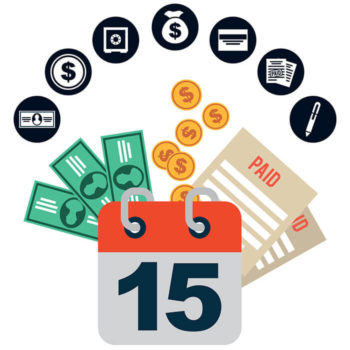Your PPP funds have arrived, and now you need to work on forgiving the loan. With vague and ever-changing guidelines, it’s hard to know where to start. If you make a mistake, it could mean having to pay back money you thought would be forgiven. Pacific Crest Group can help guide you through this challenging process with expertise and care.

Have you been approved for the PPP funding? Is the money sitting in your bank account? Do you feel you have a bigger problem now than when you started? Right about now, you and thousands of others are asking “how do I get this money forgiven? What will happen next?”
Unfortunately, Congress’ rush to enact the legislation created a lot of vagueness and uncertainty. Some areas of the law are open to interpretation, and the federal government is still trying to create some additional guidance.
Given all the rules and the chance of a government audit, you need to be careful. That is why you should maintain communications with your bank and financial professionals as you begin to wade into the loan forgiveness process. Here at Pacific Crest Group, we are ready to help you navigate this challenging environment.
|
|
Loan Forgiveness Application.
On May 15, the federal government released the PPP Loan Forgiveness Application. The application must be completed and submitted to your lender. The lender is ultimately responsible for deciding on loan forgiveness. The loan can be forgiven if it is utilized in the proper way — such as 75 percent being spent on payroll — and the expenses are properly documented. The approved expenses are:
• Payroll costs including group health care benefits (75%)
• Mortgage interest payments
• Rent payments
• Utility payments
• Interest payments on other debt obligations
• Refinancing of an SBA Economic Injury Disaster Loan
Companies “are generally eligible for forgiveness for the payroll costs paid and payroll costs incurred during the eight-week (56-day)” but payroll “costs incurred but not paid during the Borrower’s last pay period of the Covered Period (or Alternative Payroll Covered Period) are eligible for forgiveness if paid on or before the next regular payroll date,” according to the application. The covered period begins the first day of the start of the payroll period after the loan is funded.
Businesses are expected to keep payroll at the same level as before the stay-at-home orders were enacted. The application seeks the company’s FTE between Feb 15, 2020 and April 26, 2020. The language and the structure create numerous challenges for business. Businesses like restaurants are an example. In the current climate, restaurants do not need the same amount of staffing as before. It’s unclear how many people will be needed to operate a restaurant even if it can open for sit-down service. The Treasure Secretary has stated that he wants to fix this problem, but currently no solution exists. So, you have to be very cautious how you submit your forgiveness application.

|
|
Non-payroll uses.
Congress allowed for “qualified expenses” to be forgiven. Rent, mortgage, utilities, and other expenses can qualify for forgiveness. What are considered utilities is unclear The law states “utilities” but provides no definition. The SBA defines utilities as “electricity, water, gas, telephone, or internet,” but the PPP does not clearly define it, which means you may need a CPA or financial professional to help you manage the expense.
The role of modified rent payments remains unclear. Rent is a qualified expense if it was active on Feb 15, 2020, but it’s not clear what happens if late penalties have been incurred or rent modifications have been negotiated.
Taxes
Besides the challenges of qualifying for loan forgiveness, you also have to deal with the tax implications. According to recent guidance from the IRS, a business is not allowed to deduct an expense “if the payment of the expense results in forgiveness of a covered loan.” That means that payroll, rent, and other expenses that are used to document loan forgiveness cannot be used as a tax deduction, which would be a normal way to expense.
The implication may be taxable income. If you continue to receive income from past A/R or ongoing services, you may realize the profit you were not counting on. It’s important to plan ahead for the potential tax consequences at the end of your tax year; forecasting will be incredibly valuable.
Proper documentation
The key to loan forgiveness is proper documentation. The PPP program and the corresponding loan forgiveness is based on what you spent, not on the amount you borrowed. If a borrower uses PPP funds for unauthorized purposes, the SBA could direct the borrower to repay those amounts. If a borrower knowingly uses the funds for unauthorized purposes, the borrower could be subject to possible penalties and fines.
It’s important to compile information as it relates to the expenses you are claiming on your loan forgiveness application. You must provide verification of full-time equivalent employees, pay rates, payroll reports, bank statements, rent and other payment receipts, and any other expense being claimed on the form.
Be sure to make sure every base is covered when you submit the application to your lender. It’s possible you may open yourself up to an audit or additional scrutiny from the lender. We can help you understand every expense that you allocate to the PPP, and ensure that at least 75% of the PPP loan is used for payroll.
Proper forecasting
The PPP loan program is for a short period of time, but the pandemic will be with us for some time. As a business owner, you need to decide where the PPP fits into your overall strategy and your long-term financial forecasting. Pacific Crest Group has the expertise to assist in formulating a plan for your future. We will help you to understand not only how you are going to survive the eight weeks of the PPP program but how it all fits into your financial future for 2020. What happens if the economy does not return to the levels before the crisis? Are you prepared for that? What can you do to position yourself in a financially secure way? We can help guide you.
PCG can help make this process easier!
Cash flow
The PPP loan can help alleviate short-term cash flow problems, but you need to think about whether additional funding is needed to maintain your business. Do you have a line of credit with a lending institution? Would now be a good time to draw on that or do you need to increase the credit line? Can you get a loan based on assets within the business? These are important questions that you and your financial advisors need to be discussing.
COVID19 has fundamentally changed the way business is conducted. The more you plan and adjust the better prepared you will be able to navigate through this.
[/vc_column_text][vc_column_text]
Contact us for more information
Pacific Crest Group
We Guide Business Owners with Strategic Accounting and HR Services
[/vc_column_text][/vc_column][/vc_row]


